JHP Newsletter - 2015, No. 2, 17 April
Greetings from Franktown, Colorado.
Travel: South Africa
I had a fantastic eight weeks in South Africa that was very productive photographically. I made a two-lobed circuit around the country visiting Kgalagadi Transfrontier Park in the northwest, Karoo, Mountain Zebra, and Addo Elephant National Parks in the south, and Kruger National Park in the east.
Kgalagadi Transfrontier Park
I started with eight nights at the end of February in Kgalagadi Transfrontier Park, which encompasses the former Kalahari Gemsbok National Park. It's one of my favorite parks anywhere because it's remote and lightly visited, although it has become much more popular in recent years. It is also very good for photography because of the rather open terrain.
I pulled into a waterhole early one morning to see what might be there when I saw a group of springbok running towards the waterhole from further downstream in the dry Auob River. When the dust cleared, I saw a cheetah (Acinonyx jubatus) standing there wondering what happened to breakfast. I quickly drove down the road and captured this nice backlit image (below L). The next morning I was driving along the dry Auob River when I saw what looked like smoke rising from the ground. I stopped to investigate and after a while a Cape fox, Cama fox, or silver-backed fox (Vulpes chama) came out of its den. The "smoke" was backlit dust rising out of the den as it was being excavated. I got some nice images of the fox, but my favorite image(s) came the next morning when I returned to the den (below R).

1/1000 sec, f5.6, ISO 800
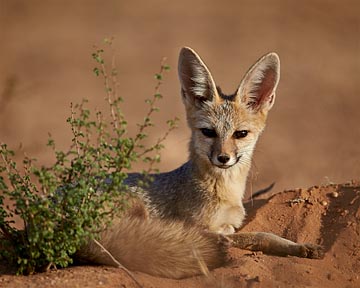
1/1500 sec, f5.6, ISO 250
An early highlight was seeing three different brown hyena (Hyaena brunnea, formerly Parahyaena brunnea) all on one day! Prior to my previous visit, I had never seen one before, so seeing three, and being able to photograph two of them, was a real treat. This one was the last one of the day and it gave me lots of good opportunities to photograph it right next to the road and then after it crossed the road (below L). One of my favorite images from the entire visit to South Africa is this one (below R) of a baby Cape ground squirrel (Xerus inauris). I enjoy photographing these prairie-dog-like rodents, and I was surprised to see this little one in the middle of the road with no adults nearby. It seemed unconcerned that I was there photographing first from the car and then from ground level with the camera supported by a beanbag on the ground.
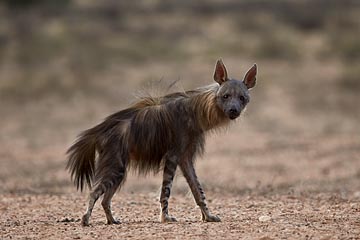
1/125 sec, f5.6, ISO 640
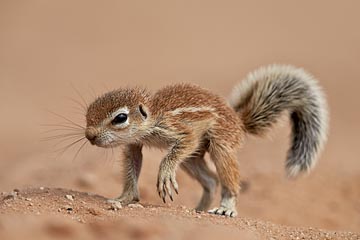
1/1000 sec, f8, ISO 320
The park is one of the best places in South Africa to see and photograph lions (Panthera leo), and one pride gave me some nice photo ops one morning. I always love to get head shots when the subject is looking right down the lens like this lioness was (below L). I had two good opportunities to photograph small common ostrich (Struthio camelus) chicks. This one (below R) stood about 2 ft (60 cm) tall.
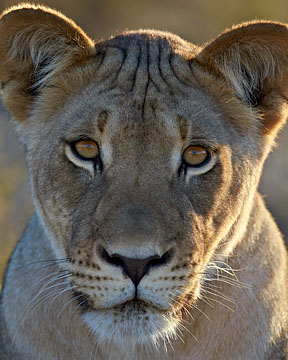
1/750 sec, f5.6, ISO 800

1/2000 sec, f8, ISO 400
I enjoy photographing the unique hornbills, and this southern yellow-billed hornbill (Tockus leucomelas, below L) was about to eat a grasshopper — an added bonus! I had seen two springbok (Antidorcas marsupialis) bucks spar many times before, but these two had a long serious fight one morning (below R).
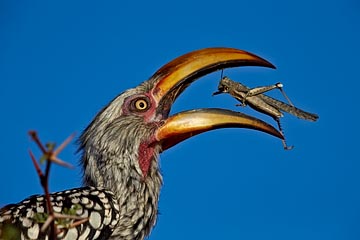
1/1500 sec, f8, ISO 400
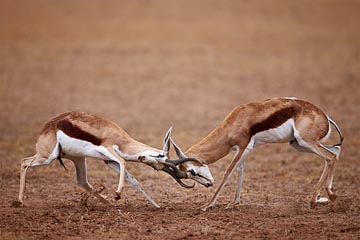
1/350 sec, f4, ISO 800
Karoo, Mountain Zebra, and Addo Elephant National Parks
After Kgalagadi, I spent two nights in Karoo National Park in early March. I haven't been there since 2007 shortly after they greatly expanded the park and were starting to add new roads. It had been a nice park, mainly for prey animals, but it wasn't one of the most productive parks for photography so that's why it's been off my itinerary for the last few visits. I wanted to go back to explore the park on the new roads and possibly see and photograph the lions which they had reintroduced. I didn't see the lions, but did get some nice images of red hartebeest, greater kudu, and mountain zebra. While photographing a greater kudu (Tragelaphus strepsiceros) buck (below L), a red hartebeest (Alcelaphus buselaphus) buck chased an intruding buck away from his girls (below R).

1/3000 sec, f5.6, ISO 500
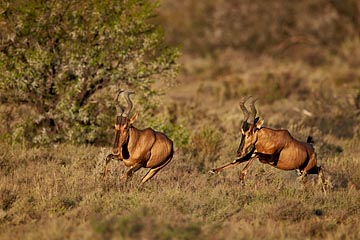
1/750 sec, f5.6, ISO 200
Then I spent three nights in Mountain Zebra National Park in early March. I enjoy visiting the park for the mountain zebra and blesbok and the wonderful mountainous terrain. On this visit, I had great encounters with yellow mongoose (Cynictis penicillata). They're usually quite active and skittish and are typically on the move more than 30 yds (25 m) out. The one in this image was part of a group of three that were actively hunting. Two of them were in non-stop motion among the tall grass and small bushes, but this one stopped to prairie-dog for me less than 10 yds (9 m) away (below L). While photographing a group of blesbok with calves one morning, some nearby springbok (Antidorcas marsupialis) started to run. While photographing one buck, it suddenly sprung up and I was thrilled to finally have photographed a springbok springing (below R)!
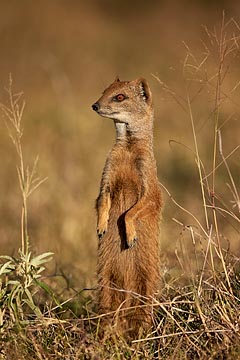
1/2000 sec, f4, ISO 200
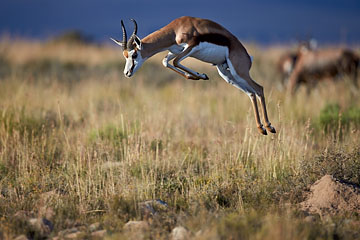
1/750 sec, f4, ISO 100
Then I spent three nights in Addo Elephant National Park in mid March. While it's a great place to photograph elephants, but it has also been rather good to me for other species, including lion (Panthera leo). I found this guy and his brother using the tried and true method of spotting vehicles stopped on the road ahead. When I got there, the lions were approaching the road and I couldn't get to the other side of them to make a good image; one that was front lit and with the animals walking towards me. So, I backed up to get them backlit as they crossed in front of me and made this good image instead (below L). I photographed many warthogs (Phacochoerus aethiopicus) in Addo, and this guy (below R) was standing on a slight rise so I had an almost eye-level perspective. You can tell it's a male because he has two sets of warts on his face. Females only have warts by their eyes.
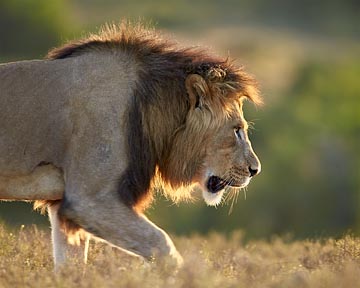
1/125 sec, f5.6, ISO 250
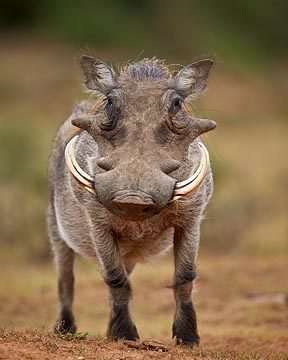
1/1000 sec, f4, ISO 250
Kruger National Park
I spent eighteen nights in Kruger National Park from mid March through early April. That's longest I've ever spent in Kruger, and did so because Kruger was so productive the last time I visited. It wasn't quite as productive this time, but I got lots of great images and it was definitely time well spent.
I'm a cat person, and my visit started off with a bang — my first subject was a caracal (Caracal caracal). I hadn't seen one of these rare cats yet on this trip, which is typical, so I was thrilled when I saw this one on the road. By the time I got close enough to photograph it, it had moved just off the road and into the bush. I was able to find an angle where I could photograph it giving me the evil eye while waiting for me to leave (below L). When I moved to see if I could get a better look, it took the opportunity to move further into the bush and eventually disappeared. Early one morning in the central part of the park, I came upon an African wild cat (Felis silvestris lybica) on the road. African wild cats are rare to see, but not quite as rare as caracals. They're the same species at the domestic cat, and their ancestors were the ones that domesticated humans and are now known as Felis silvestris catus. It moved off into the low grass to the left and because I didn't want to miss the opportunity, I rested the hood of my 600 on the passenger window of the right-drive car to photograph it (below R). Because it seemed quite content to sit there and watch me, I pulled ahead and turned around so that I could photograph it from the driver's window on a beanbag for more stability. As I was doing so, the cat took the opportunity to move further from the road and I eventually lost sight of it in the taller grass and bushes.
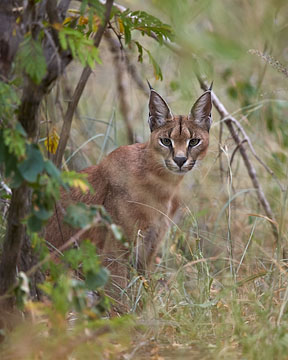
1/250 sec, f5.6, ISO 400
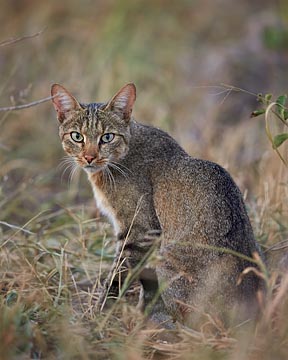
1/180 sec, f4, ISO 800
Less than 3/4 of a mile (1.2 km) down the road from the African wild cat above, I came upon a leopard (Panthera pardus) about five feet (1.5 m) from the road and heading away. He, determined from later photographs, laid down about 10 yds (9 m) out and groomed — always gotta look good if you're a cat. (Anyone a fan of Red Dwarf?) I was able to get some nice shots of him through the tall grass before he got up and continued heading away from the road. Then he turned and started paralleling the road about 30-35 yds (27-32 m) out. He stopped occasionally to groom some more because the tall grass was obviously messing up his coiffure. At one of the grooming stops, he was completely obscured by the tall grass when another vehicle pulled up next to me. I told the guy that there was a leopard straight out but that it wasn't visible at the moment, and he said, "It's moving!" Sure enough, the leopard had started paralleling the road again. The other guy and his family left after just a few minutes and I couldn't believe it — they probably weren't cat people. Either that or they were on a mission to see the Big Five: cape buffalo, elephant, leopard, lion, and black rhino, but usually any kind of rhino will do, especially if you're on a tight schedule. By spending three minutes with one of the five, they could check it off the list and then go search for the others. The leopard started to make his way closer and closer to the road, and that's when the photography got really interesting (below L). He eventually crossed the road and continued his course through the sea of tall grass.

1/500 sec, f5.6, ISO 500
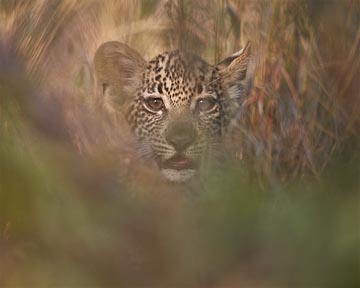
1/750 sec, f5.6, ISO 500
About an hour after that leopard encounter, I decided to take a short loop road to get right up to the riverbank. It was a crescent-shaped excursion like a pull-through camp site but was about 100 yds (90 m) long with a maximum offset from the main road of about 25 yds (23 m). I had skipped all of the other similar loop roads on the drive because the view is from high up above the mostly dry riverbed, so if there is something down there, it wouldn't be a good shot anyways. As I turned onto the loop road, I saw a leopard (Panthera pardus) cub on the road about 30 yds (27 m) ahead of me! It was about the size of a domestic cat, so it was probably about two or three months old. Can you say "cute"?! As I approached, it moved into the bushes to the left — darn. When I got to where it went off the road, I saw its mother and a second cub about 10 ft (3 m) away. They were too close to photograph through the passenger window so I pulled ahead and made a seven-point turn to turn around on the narrow road lined with trees and bushes. By the time I got back to where I had seen the leopards, they were moving away from the road. I went back to the main road to get ahead of them and had the brilliant idea (not!) to get a family shot as they came out into the open. So I got my 100-400 ready and they didn't come out for a nice family portrait. One cub was in the lead and came out into a great location but when the mother started to come out and saw me they all stopped. It wasn't going to be an interesting shot with the 100-400 so I quickly got out the 600. While framing up the lead cub, it turned and they all started heading back into the bush — arg, still no shots! I started to back up to head them off on the loop road but they decided to head towards the junction of the main road and loop road so I met them at an opening along the way. The lead cub was mostly obscured by waving tall grass, and the autofocus did a great job focusing on the grass. The leopards turned around and disappeared into the bush and I still hadn't gotten a shot. As I was deciding whether to back down the loop road to shoot the leopards coming to the road, I saw them cross the loop road which solved that problem. I drove down the loop road and was able to get some head shots of the mother but didn't see the cubs and thought the show was over. The mother started heading away and then one of the cubs poked its head through the grass and looked right at me. I didn't even try to autofocus this time and instead immediately started to manually focus, a piece of cake when using back button focus, and bingo — I finally got a shot of one of the cubs (above R)!
I also like dogs, and had three encounters with African wild dog (Lycaon pictus), also known as African hunting dog or Cape hunting dog. This image (below L) is from the third encounter that was with a pack of four dogs. They were trotting down the road ahead of me in the same direction that I was going. After following them for a while, I squeezed over to the side of the road and passed them so I could photograph them coming towards me because the south end of a northbound dog isn't very exciting. Bushbuck or imbabala (Tragelaphus sylvaticus) are usually quite shy and spend their time hiding in thick brush, but this buck (below C) was out in the open and was a very cooperative subject. I couldn't believe it. I enjoy watching and photographing baboons because they're entertaining and almost human. This Chacma baboon (Papio ursinus) was enjoying a late-afternoon snack (below R).
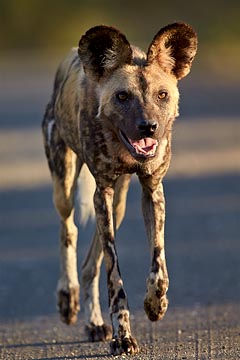
1/350 sec, f5.6, ISO 500
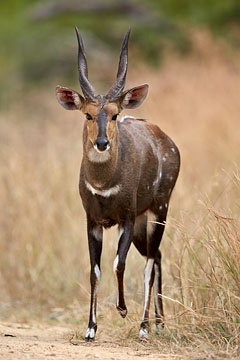
1/750 sec, f5.6, ISO 250
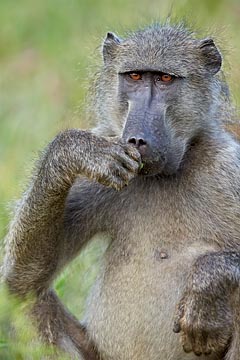
1/180 sec, f5.6, ISO 800
I photographed several flap-necked chameleon (Chamaeleo dilepis). By putting my long lens on a beanbag on the ground, I was able to get an eye-level perspective (below L). My favorite image from the last few days in Kruger is of this female impala (Aepyceros melampus) jumping. There was a large group of impala on the other side of the road from some young giraffe that I had stopped to consider photographing. Some of the young impala started running around and leaping in a large oval, almost like they were playing follow-the-leader. After several passes, this adult joined them — she must be young at heart.
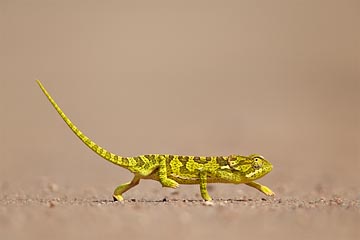
1/1000 sec, f5.6, ISO 125
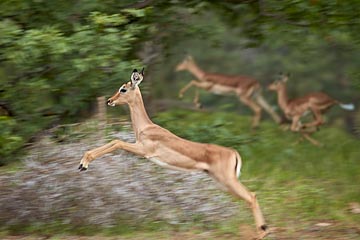
1/125 sec, f6.7, ISO 160
The southern ground-hornbill or ground hornbill (Bucorvus leadbeateri) is the largest hornbill in the world and stands about 3 ft (91 cm) tall. I photographed this male (below L) early one morning as it was hunting for food with three others. I had a blast one morning at a small waterhole with about ten black storks and two saddle-billed storks fishing. This saddle-billed stork (Ephippiorhynchus senegalensis) is preparing a fish to swallow (below C). It's fairly easy to get a nice portrait image of a zebra, but it's difficult to create a unique image of one. Having one drink ads interest, but I had a problem with this common zebra (Equus burchelli), also known as a plains zebra or Burchell's zebra, because there was a concrete pool behind this natural waterhole. While trying to minimize the concrete, I kept panning down and as soon as I saw this composition in the viewfinder I knew I had a winner (below R).
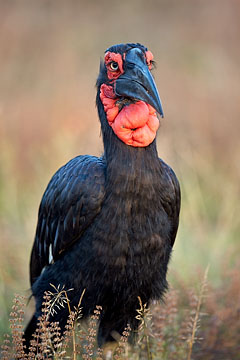
1/180 sec, f4.0, ISO 800

1/4000 sec, f4.0, ISO 400
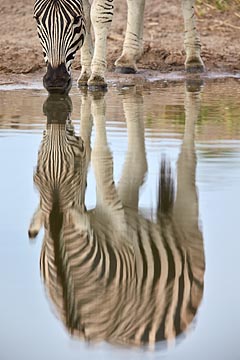
1/750 sec, f5.6, ISO 200
Take care and happy shooting.
— James
James Hager Photography :: www.jameshagerphoto.com




